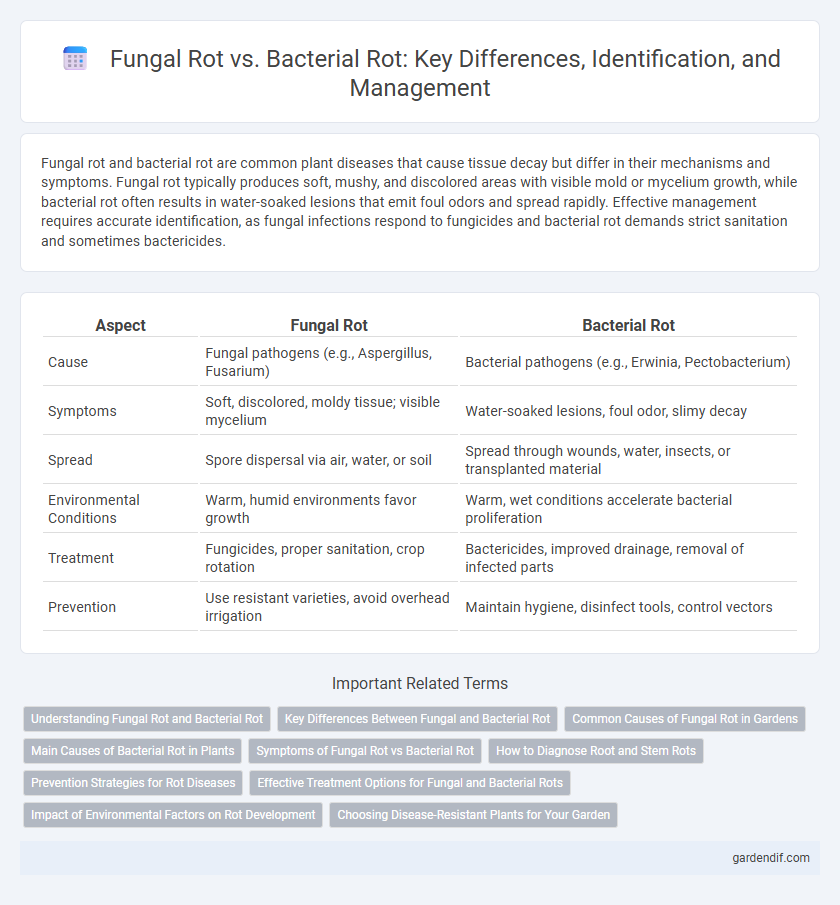
Fungal rot vs Bacterial rot Illustration
Fungal rot and bacterial rot are common plant diseases that cause tissue decay but differ in their mechanisms and symptoms. Fungal rot typically produces soft, mushy, and discolored areas with visible mold or mycelium growth, while bacterial rot often results in water-soaked lesions that emit foul odors and spread rapidly. Effective management requires accurate identification, as fungal infections respond to fungicides and bacterial rot demands strict sanitation and sometimes bactericides.
Table of Comparison
| Aspect | Fungal Rot | Bacterial Rot |
|---|---|---|
| Cause | Fungal pathogens (e.g., Aspergillus, Fusarium) | Bacterial pathogens (e.g., Erwinia, Pectobacterium) |
| Symptoms | Soft, discolored, moldy tissue; visible mycelium | Water-soaked lesions, foul odor, slimy decay |
| Spread | Spore dispersal via air, water, or soil | Spread through wounds, water, insects, or transplanted material |
| Environmental Conditions | Warm, humid environments favor growth | Warm, wet conditions accelerate bacterial proliferation |
| Treatment | Fungicides, proper sanitation, crop rotation | Bactericides, improved drainage, removal of infected parts |
| Prevention | Use resistant varieties, avoid overhead irrigation | Maintain hygiene, disinfect tools, control vectors |
Understanding Fungal Rot and Bacterial Rot
Fungal rot and bacterial rot are plant diseases caused by distinct pathogens that degrade plant tissues, leading to decay and yield loss. Fungal rot often presents as soft, mushy lesions with visible mycelium, thriving in humid conditions, while bacterial rot typically causes watery, foul-smelling soft spots due to bacterial enzymatic activity. Accurate identification through symptoms and laboratory tests is crucial for effective management and control of these rot diseases in agriculture.
Key Differences Between Fungal and Bacterial Rot
Fungal rot typically causes soft, mushy decay with visible mycelium and spores, often developing in moist, warm environments, while bacterial rot leads to slimy, foul-smelling lesions and spreads rapidly through plant tissues. Fungal pathogens like Botrytis cinerea invade through wounds, producing enzymes that degrade cell walls, whereas bacterial pathogens such as Erwinia spp. use toxins and enzymes to break down plant cells and cause systemic infection. Control measures for fungal rot generally involve fungicides and improved airflow, whereas bacterial rot management relies on sanitation, resistant cultivars, and bactericides.
Common Causes of Fungal Rot in Gardens
Fungal rot in gardens is commonly caused by pathogens such as Phytophthora, Fusarium, and Rhizoctonia species that thrive in moist, poorly drained soils. Overwatering, excessive humidity, and warm temperatures create ideal conditions for these fungi to infect plant roots, stems, and fruits. Proper garden hygiene, soil aeration, and fungicide application can help prevent the spread of fungal rot.
Main Causes of Bacterial Rot in Plants
Bacterial rot in plants is primarily caused by pathogenic bacteria such as Erwinia, Pectobacterium, and Ralstonia species, which invade plant tissues through wounds or natural openings. These bacteria produce enzymes that degrade cell walls, leading to tissue maceration and soft rot symptoms. High humidity, poor drainage, and physical damage increase the susceptibility of plants to bacterial rot infections.
Symptoms of Fungal Rot vs Bacterial Rot
Fungal rot typically manifests as soft, water-soaked lesions with a fuzzy or powdery appearance on plant tissues, often accompanied by discoloration ranging from brown to black. Bacterial rot symptoms include slimy, foul-smelling tissue decay, with irregular, mushy spots that may ooze bacterial exudate. Both diseases cause tissue breakdown, but fungal rot often produces visible fungal structures, while bacterial rot results in a more liquid, mushy consistency without fungal growth.
How to Diagnose Root and Stem Rots
Root and stem rots caused by fungal pathogens typically present with dark, water-soaked lesions and a distinct mycelial growth, while bacterial rot often results in soft, mushy tissues with an unpleasant odor. Diagnosing these rots involves careful examination of symptoms alongside laboratory tests such as fungal culture or bacterial isolation to accurately identify the pathogen. Molecular techniques like PCR can provide precise identification, enabling targeted treatment and effective disease management.
Prevention Strategies for Rot Diseases
Effective prevention strategies for fungal rot focus on maintaining proper soil drainage, using disease-free seeds, and applying fungicidal treatments to reduce spore proliferation. Bacterial rot prevention emphasizes sanitation practices such as sterilizing tools, removing infected plant material promptly, and avoiding excessive moisture to inhibit bacterial growth. Crop rotation with non-host plants and resistant cultivars plays a critical role in minimizing both fungal and bacterial rot disease incidence.
Effective Treatment Options for Fungal and Bacterial Rots
Effective treatment options for fungal rot typically include systemic fungicides such as azoxystrobin, tebuconazole, or copper-based compounds that inhibit fungal growth and spore germination. Bacterial rot management relies on bactericides like copper hydroxide and streptomycin, combined with strict sanitation practices to prevent bacterial spread and biofilm formation. Early diagnosis and the use of resistant plant varieties enhance the success of chemical treatments and reduce crop losses caused by both fungal and bacterial rots.
Impact of Environmental Factors on Rot Development
Fungal rot development thrives in warm, moist environments where high humidity and poor air circulation promote spore germination and mycelial growth. Bacterial rot is accelerated by waterlogged soils and wounds that allow bacterial entry, with temperature fluctuations influencing bacterial proliferation. Both rots show increased severity under stress conditions such as nutrient deficiencies and physical plant damage, which compromise plant defenses.
Choosing Disease-Resistant Plants for Your Garden
Choosing disease-resistant plants significantly reduces the risk of fungal rot and bacterial rot in your garden by providing natural immunity against specific pathogens like Phytophthora and Erwinia species. Selecting cultivars with genetic resistance to these diseases enhances plant health, minimizes the need for chemical treatments, and promotes sustainable gardening practices. Gardeners should prioritize varieties with documented resistance ratings from reputable sources such as university extension services or agricultural research institutions.
Fungal rot vs Bacterial rot Infographic

 gardendif.com
gardendif.com